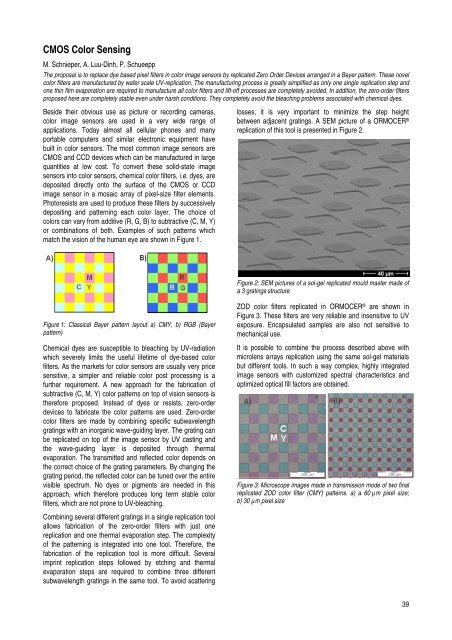CSEM Scientific and Technical Report 2008
CSEM Scientific and Technical Report 2008
CSEM Scientific and Technical Report 2008
You also want an ePaper? Increase the reach of your titles
YUMPU automatically turns print PDFs into web optimized ePapers that Google loves.
CMOS Color Sensing<br />
M. Schnieper, A. Luu-Dinh, P. Schueepp<br />
The proposal is to replace dye based pixel filters in color image sensors by replicated Zero Order Devices arranged in a Bayer pattern. These novel<br />
color filters are manufactured by wafer scale UV-replication. The manufacturing process is greatly simplified as only one single replication step <strong>and</strong><br />
one thin film evaporation are required to manufacture all color filters <strong>and</strong> lift-off processes are completely avoided. In addition, the zero-order filters<br />
proposed here are completely stable even under harsh conditions. They completely avoid the bleaching problems associated with chemical dyes.<br />
Beside their obvious use as picture or recording cameras,<br />
color image sensors are used in a very wide range of<br />
applications. Today almost all cellular phones <strong>and</strong> many<br />
portable computers <strong>and</strong> similar electronic equipment have<br />
built in color sensors. The most common image sensors are<br />
CMOS <strong>and</strong> CCD devices which can be manufactured in large<br />
quantities at low cost. To convert these solid-state image<br />
sensors into color sensors, chemical color filters, i.e. dyes, are<br />
deposited directly onto the surface of the CMOS or CCD<br />
image sensor in a mosaic array of pixel-size filter elements.<br />
Photoresists are used to produce these filters by successively<br />
depositing <strong>and</strong> patterning each color layer. The choice of<br />
colors can vary from additive (R, G, B) to subtractive (C, M, Y)<br />
or combinations of both. Examples of such patterns which<br />
match the vision of the human eye are shown in Figure 1.<br />
Figure 1: Classical Bayer pattern layout a) CMY, b) RGB (Bayer<br />
pattern)<br />
Chemical dyes are susceptible to bleaching by UV-radiation<br />
which severely limits the useful lifetime of dye-based color<br />
filters. As the markets for color sensors are usually very price<br />
sensitive, a simpler <strong>and</strong> reliable color post processing is a<br />
further requirement. A new approach for the fabrication of<br />
subtractive (C, M, Y) color patterns on top of vision sensors is<br />
therefore proposed. Instead of dyes or resists, zero-order<br />
devices to fabricate the color patterns are used. Zero-order<br />
color filters are made by combining specific subwavelength<br />
gratings with an inorganic wave-guiding layer. The grating can<br />
be replicated on top of the image sensor by UV casting <strong>and</strong><br />
the wave-guiding layer is deposited through thermal<br />
evaporation. The transmitted <strong>and</strong> reflected color depends on<br />
the correct choice of the grating parameters. By changing the<br />
grating period, the reflected color can be tuned over the entire<br />
visible spectrum. No dyes or pigments are needed in this<br />
approach, which therefore produces long term stable color<br />
filters, which are not prone to UV-bleaching.<br />
Combining several different gratings in a single replication tool<br />
allows fabrication of the zero-order filters with just one<br />
replication <strong>and</strong> one thermal evaporation step. The complexity<br />
of the patterning is integrated into one tool. Therefore, the<br />
fabrication of the replication tool is more difficult. Several<br />
imprint replication steps followed by etching <strong>and</strong> thermal<br />
evaporation steps are required to combine three different<br />
subwavelength gratings in the same tool. To avoid scattering<br />
losses, it is very important to minimize the step height<br />
between adjacent gratings. A SEM picture of a ORMOCER ®<br />
replication of this tool is presented in Figure 2.<br />
Figure 2: SEM pictures of a sol-gel replicated mould master made of<br />
a 3 gratings structure<br />
ZOD color filters replicated in ORMOCER ® are shown in<br />
Figure 3. These filters are very reliable <strong>and</strong> insensitive to UV<br />
exposure. Encapsulated samples are also not sensitive to<br />
mechanical use.<br />
It is possible to combine the process described above with<br />
microlens arrays replication using the same sol-gel materials<br />
but different tools. In such a way complex, highly integrated<br />
image sensors with customized spectral characteristics <strong>and</strong><br />
optimized optical fill factors are obtained.<br />
Figure 3: Microscope images made in transmission mode of two final<br />
replicated ZOD color filter (CMY) patterns. a) a 60 µm pixel size;<br />
b) 30 µm pixel size<br />
39








